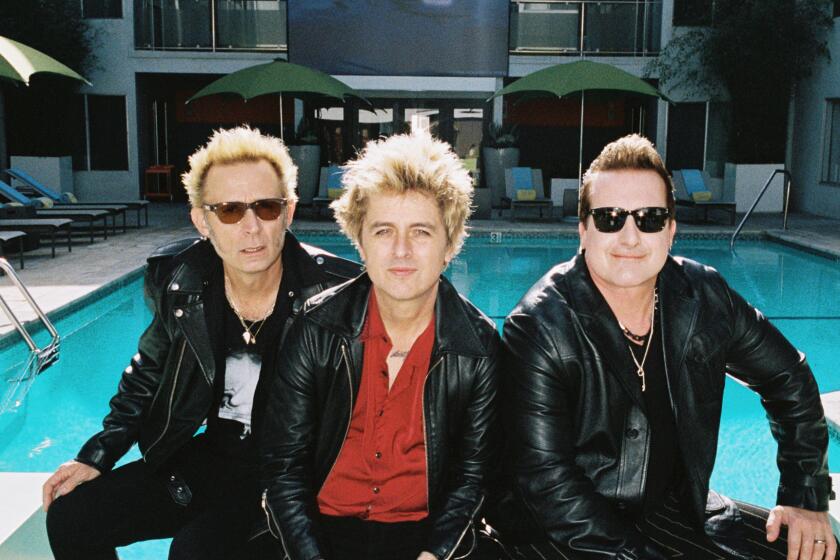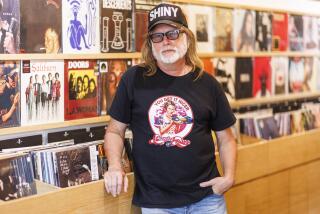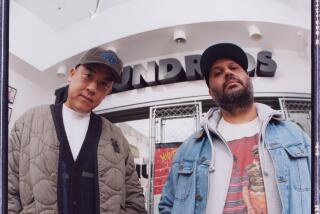Hopeless Records created a visionary path for pop-punk. 30 years later, it keeps on moshing

- Share via
Just a few years before he founded Hopeless Records in his early 20s, Louis Posen thought he saw a future for himself in the film industry.
That was before doctors diagnosed him with retinitis pigmentosa at 19, leaving him with the knowledge that he’d be losing his eyesight at a very young age.
“Being in a doctor’s office at 19 and hearing that you’re going to slowly lose your eyesight with no treatment or cures, there’s no hope — so I guess I had that stamp on my back of being ‘hopeless’ from that moment,” Posen says. “I was a film student who thought I could change the world through media, and I think [the diagnosis] fueled me.”
But just before he became legally blind in 1994 at age 23, Posen picked up a book about how to run an indie record label written by an employee at SST Records, the legendary South Bay label founded in 1978 by Black Flag guitarist Greg Ginn. Between that book and a budding friendship with Mike “Fat Mike” Burkett of the band NOFX and his label Fat Wreck Chords — one born out of Posen volunteering to produce, direct and fund a music video for NOFX’s 1992 single “Bob” — the young punk had all he needed to push his budding career aspirations in a different direction.
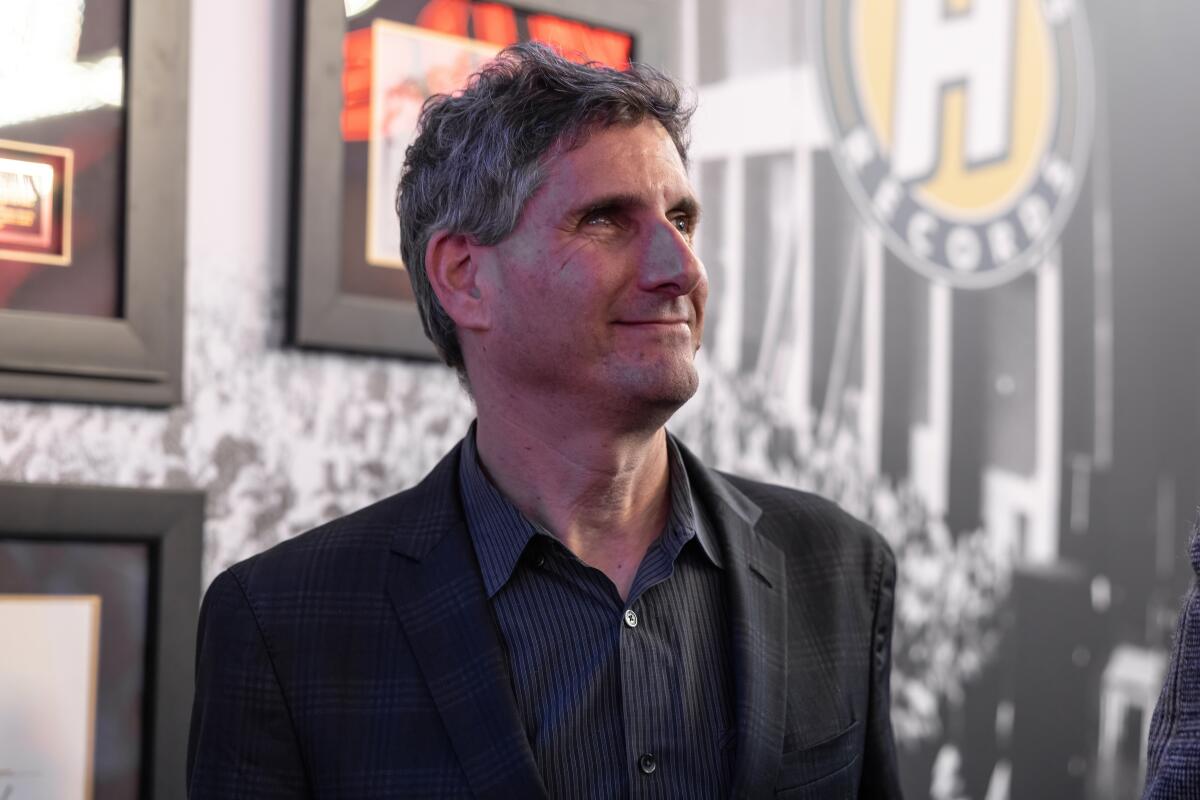
“I called 411, asked for Epitaph Records, and they gave me [Burkett’s] number,” Posen recalls. “I called him and told him I had some money to do a music video for him, and we’ve been friends ever since. When I started the label, Mike was one of the few people I knew in the music business, so I called him and said, ‘Hey, how do you put a record out?’ He connected me with a lot of the Fat Wreck Chords staff, and they were super helpful. I stayed friends with that whole team for a long time. They were a great help in the early years of Hopeless.”
From that first 7-inch EP (1993’s “11oz.” by Huntington Beach punk band Guttermouth), Posen launched what would become one of the most consistent and impactful labels in the Southern California punk-alternative-hardcore scene. Beginning with the pop-punk and ska of the 1990s before transitioning to the mainstream rise of local rock artists like Thrice and Avenged Sevenfold, Hopeless established itself as a haven for emerging and veteran artists alike — eventually hosting comeback albums for bands like Taking Back Sunday and New Found Glory.
But perhaps most important, Posen and the rest of the Hopeless crew have remained true to themselves while evolving with the times. Whereas some indie labels dominate a single musical generation only to slip from relevance when those bands fall out of popularity, Hopeless has maintained its footing through three decades, with a roster that includes some of today’s emerging acts (like Destroy Boys) alongside timeless veterans (such as Bayside).

As Burkett can attest, withstanding the trends and waves of popularity within the music world isn’t an easy task for any label.
“When I went to the Hopeless 30th anniversary party, it was so unlike Fat Wreck Chords, because there were so many young, vibrant, new bands who are basically kids,” Burkett says. “Kids like to listen to kids — 14-year-olds don’t want to listen to 60-year-olds. Hopeless has been around for a long time, but they’re still very current. I think they’re always paying attention to what’s happening, which isn’t how I run my label. I have an aversion to signing young bands that want to be popular. It’s not a good business move on my part, but Louis understands things like pop-punk, and I don’t.”
The label celebrated its 30th birthday by launching a traveling exhibit that debuted in early December at the Valley Relics Museum in Van Nuys (and will be at both the Rock & Roll Hall of Fame in Cleveland and the Punk Rock Museum in Las Vegas later this year). The exhibit has forced the Hopeless team to do a lot more reflection and looking back at their own history than they usually do. Being one of the most relevant and evolving alternative indie labels generally means always looking ahead and never spending too much time in the rearview mirror.
“Building this 30th-anniversary museum exhibit has been a crazy journey, just going through my garage with people from our team and finding things that I had no idea still existed,” Posen says. “I’m always either trying to be in the moment or thinking forward about how I can be better, so I rarely spend time on those types of reflections. It’s been really cool to see all of the people who contributed to this, and it’s been incredible to see how different things are in this business, as well as how many things are exactly the same.”
One aspect of Hopeless that has assuredly aided in the label’s success is the steadiness of some of its key staff members. In an industry known for volatile careers and high turnover, several longtime Hopeless staffers have been working with Posen for decades. For instance, Chief Financial Officer Alan Person was a Cal State Northridge student who happened to rent a room in the same house as Posen in 1996. After Person graduated in 1998, there was no one he wanted to put his degree to work for more than Posen. General Manager Ian Harrison joined in 2005, just in time for some of the label’s biggest albums, and has been a major part of the team leading its global expansion ever since.
“Looking back at 30 years really makes it clear how big an impact the label has had on the Southern California music community and how much we’ve done globally — with several international artists and top-charting records,” Harrison says. “It’s amazing that from our office in Van Nuys, we’ve been able to make a positive impact with alternative music fans around the world.”
Unlike Hopeless’ staff, the label’s artist roster has changed with the times, not only fit to the trends but also to provide representation for all types of groups within alternative music. Whereas fans generally know what to expect from bands on a label like Fat Wreck Chords, the biggest stars on Hopeless over the years have ranged from bombastic pop punk to thoughtful indie to aggressive metalcore — and that’s not even factoring in the various backgrounds and communities the artists come from.
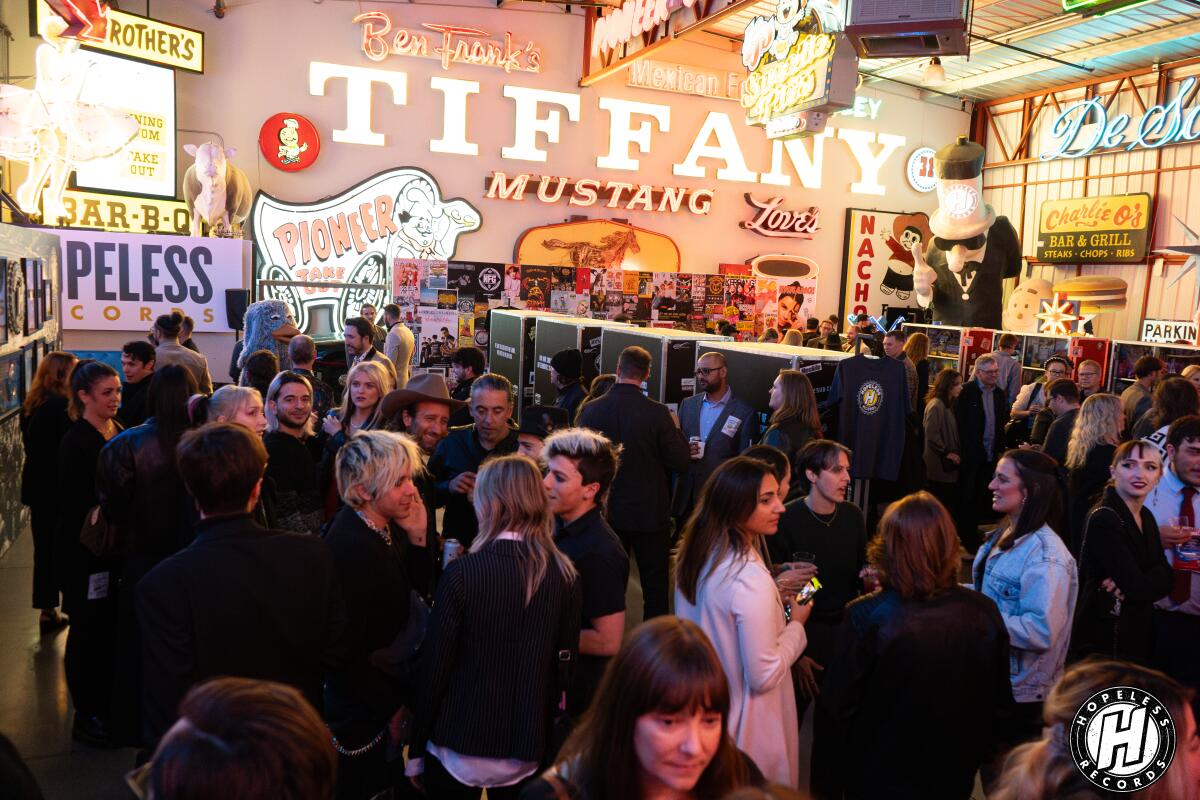
“I think what makes Hopeless special is that there’s not one specific Hopeless ‘sound’ or ‘genre,’” says Erin Choi, vice president of marketing and product management. “Each artist we work with has a unique story, message and sound — but the main throughline is their ability to connect with fans and the talent and passion that exudes from their music. [Many of Hopeless’ biggest artists] sound completely different from each other, but all have coined their own subgenres and sit at the top of the mountain in their respective areas.”
“What makes Hopeless Records truly special is our vibrant tapestry of sound and representation,” says Enoch Chuang, director of finance and royalties. “We’ve not only partnered with artists from almost every subgenre within the alternative scene but also defied the ‘scene’ norms of straight white males by uplifting women, LGBTQ+ and POC artists and fostering an inclusive and compassionate community.”
Of course, none of that would matter if Hopeless treated its artists poorly or was disliked in the industry. Having spent four decades on both sides of that relationship, Burkett’s not shy about the fact that Posen has maintained a much better relationship with many names on his roster than most labels do.
“Hopeless has a very good reputation for treating bands well,” Burkett says. “I was talking to Matt [Sanders] from Avenged Sevenfold because we golf sometimes, and I asked him, ‘What’s Hopeless like? Should I go to their party?’ He said Hopeless always treats them right and that Louis is a good businessman, and I like to hear that from bands. There are so many labels that no one can say anything good about, whereas I’ve never heard anybody say anything bad about Hopeless.”
More to Read
The biggest entertainment stories
Get our big stories about Hollywood, film, television, music, arts, culture and more right in your inbox as soon as they publish.
You may occasionally receive promotional content from the Los Angeles Times.
